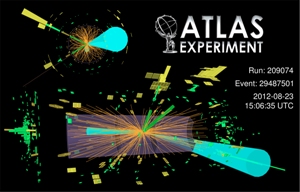Dec 5 2013
At a CERN seminar November 26th, Aliaksandr (Sasha) Pranko of the Physics Division at the U.S. Department of Energy’s Lawrence Berkeley National Laboratory (Berkeley Lab) presented key direct evidence that the “Higgs-like” particle discovered at CERN last year does what a Higgs is supposed to do: it couples not only to other bosons but to fermions as well. Pranko is a member of Berkeley Lab’s contingent of the ATLAS Collaboration at the Large Hadron Collider.
 One of the ATLAS candidate events in which the collision of two protons yields a Higgs boson, which subsequently decays to two tau leptons.
One of the ATLAS candidate events in which the collision of two protons yields a Higgs boson, which subsequently decays to two tau leptons.
Pranko reported the results of the ATLAS search for pairs of fermions – including quarks, constituents of hadrons such as protons, and leptons, particles in their own right such as electrons and neutrinos. The ATLAS search concentrated on finding pairs of bottom (b) quarks; pairs of muons, which are heavier “cousins” of the electron; and pairs of tau leptons, cousins of the electron that are heavier still.
The b-quark and muon searches yielded no events in excess of the cluttered experimental background, but the search for pairs of tau particles yielded striking results, showing marked evidence at a high level of confidence that a Higgs boson can indeed decay to a pair of taus. This was the first evidence that the Higgs couples with leptons.
“Since Higgs coupling should be dependent on particle mass, tau coupling should be much bigger than muon coupling,” says Ian Hinchliffe, who leads Berkeley Lab’s ATLAS contingent. “The ATLAS experiment has very high resolution in muons, but the expected signal is very small.” And detecting decay to a pair of taus is very complicated, due to the large backgrounds and the missing energy carried off by neutrinos from the tau decays.
Hinchliffe credits Pranko with co-inventing the “Missing Mass Calculator” method of reconstructing particle masses, in particular those of tau pairs, and serving as co-leader of the group responsible for the ATLAS Collaboration’s analysis of the data that revealed the Higgs’s coupling to the tau lepton.
The ATLAS results were based on the full data set with the LHC’s colliding beams running at 8 TeV (eight trillion electron volts) center-of-mass proton collisions during the last year of its run, before it recessed for maintenance. The LHC is now preparing for even higher energy runs beginning in 2015.
At a CERN seminar on December 3rd, the CMS experiment showed its updated results, which confirm the ATLAS observation in the tau-tau final state.